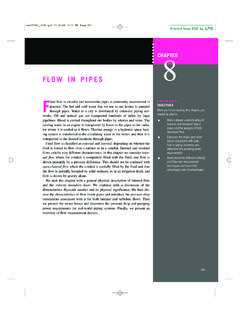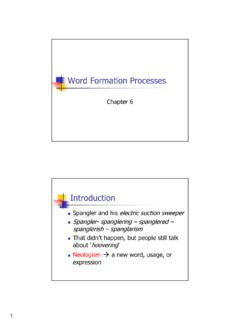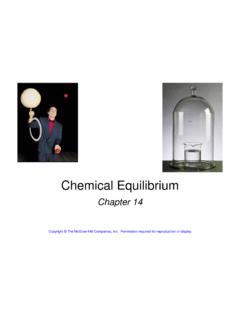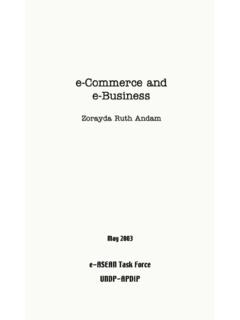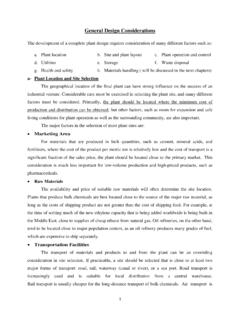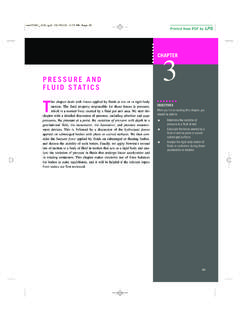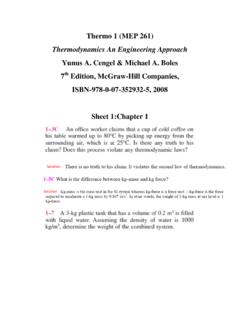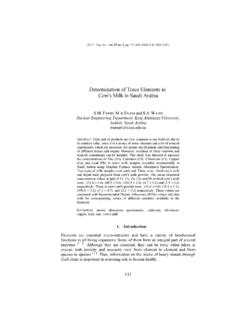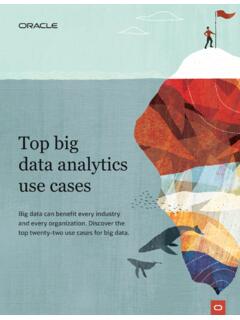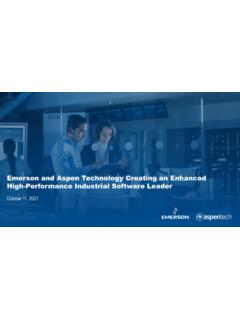Transcription of Plant Design CHEN 451 - kau
1 1 Plant Design CHEN 451 Engineering Design of new chemical and petrochemical plants and the expansion or revision of existing ones require the use of engineering principles and theories combined with a practical realization of the limits imposed by industrial conditions. A successful engineer needs more than a knowledge and understanding of the fundamental sciences and the related engineering subjects such as thermodynamics, reaction kinetics, and computer technology. The engineer must also have the ability to apply this knowledge to practical situations for the purpose of accomplishing something that will be beneficial to society.
2 There are three parameters that must be defined namely: 1- Design : Design is a creative activity and is defined as the synthesis, the putting together of ideas to achieve a desired purpose. Also it can be defined as the creation of manufacturing process to fulfill a particular need. The need may be public need or commercial opportunity. 2-Process Design : process Design establishes the sequence of chemical and physical operations; operating conditions; the duties, major specifications, and materials of construction (where critical) of all process equipment (as distinguished from utilities and building auxiliaries); the general arrangement of equipment needed to ensure proper functioning of the Plant ; line sizes; and principal instrumentation.
3 The process Design is summarized by a process flowsheet. Process Design is intended to include: 1. Flowsheet development. 2. Process material and heat balances. 3. Auxiliary services material and heat balances (utilities requirements). 4. Chemical engineering performance Design for specific items of equipments required for a flowsheet. 5. Instrumentation as related to process performance. 6. Preparation of specifications (specification sheets) in proper form for use by the project team as well as for the purchasing function. 7. Evaluation of bids and recommendation of qualified vendor.
4 3- Plant Design : includes items related directly to the complete Plant , such as Plant layout, general service facilities, and Plant location. 2 Design Development Stages: The stages in the development of a Design , from the initial identification of the objectives to the final Design are shown in Fig.(1). (I) The Design Objectives (The Need) Engineering projects can be divided into three types: A. New process development. B. New production capacity to meet growing sales. C. Modification and addition to existing Plant . In the Design of a chemical process the need is the public need for the product, the commercial opportunity as foreseen by the sales and marketing organization.
5 (II) Setting The Design Basis (Data Collection) The most important step in starting a process Design is translating the customer need into a Design basis. The Design basis is a more precise statement of the problem that is to be solved. It will normally include the production rate and purity specifications of the main product, together with information on constraints that will influence the Design , such as: 1. Information on possible processes and the system of units to be used. 2. The national, local or company Design codes that must be followed.
6 3. Details of raw materials that are available. 4. Information on potential sites where the Plant might be located, including climate data, seismic conditions, and infrastructure availability. 5. Information on the conditions, availability, and price of utility services such as fuel (gas), steam, cooling water, process air, process water, and electricity, that will be needed to run the process. Fig.(1) The Design process. 3 (III) Generation of Possible Design Concepts (Solutions) It is the creative part of the Design process. This part is concerned with the generation of possible solutions for analysis, evaluation, and selection (ways of meeting objective problems).
7 Source of solutions: a- Past experiences. b- Tried and tested methods. (IV) Build Performance Model and Fitness Testing When Design alternatives are suggested, they must be tested for fitness of purpose. In other words, the Design engineer must determine how well each Design concept meets the identified need. In the field of chemical engineering, it is usually prohibitively expensive to build several designs to find out which one works best (a practice known as prototyping which is common in other engineering disciplines). Instead, the Design engineer builds a mathematical model of the process, usually in the form of computer simulations of the process, reactors, and other key equipment.
8 In some cases, the performance model may include a pilot Plant or other facility for predicting Plant performance and collecting the necessary Design data. The Design engineer must assemble all of the information needed to model the process so as to predict its performance against the identified objectives. For process Design this will include information on possible processes, equipment performance, and physical property data If the necessary Design data or models do not exist, then research and development work is needed to collect the data and build new models.
9 Once the data has been collected and a working model of the process has been established, then the Design engineer can begin to determine equipment sizes and costs. At this stage it will become obvious that some designs are uneconomical and they can be rejected without further analysis. From this step a few candidate designs that meet the customer objective are identified. (V) Economic Evaluation, Optimization, and Selection Once the designer has identified a few candidate designs that meet the customer objective, then the process of Design selection can begin.
10 The primary criterion for Design selection is usually economic performance, although factors such as safety and environmental impact may also play a strong role. The economic evaluation usually entails analyzing the capital and operating costs of the process to determine the return on investment ( ). The economic analysis of the product or process can also be used to optimize the Design . Every Design will have several possible variants that make economic sense under certain conditions. For example, the extent of process heat recovery is a tradeoff between the cost of energy and the cost of heat exchangers (usually expressed as a cost of heat exchange area).
